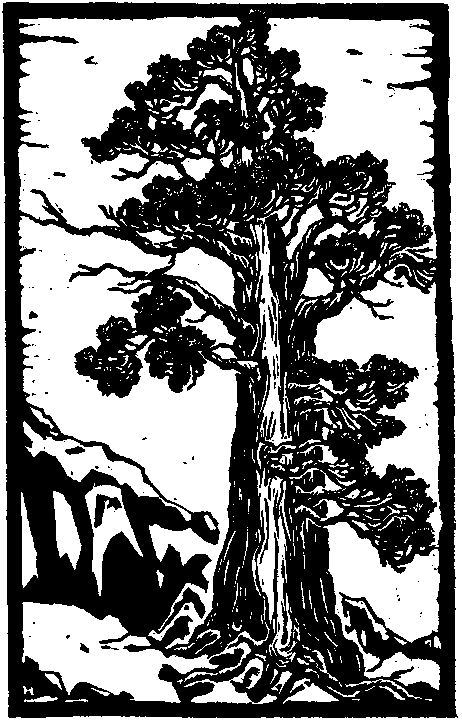
Sierra Juniper Branch
Slightly Less Than Natural Size
| Online Library: | Title | Author | California | Geology | History | Indians | Muir | Mountaineering | Nature | Management |
Yosemite > Library > Trees > Sierra Juniper >
Next: California Nutmeg • Contents • Previous: Incense Cedar
[Cypress Family]
Juniperus occidentalis Hook.

Sierra Juniper Branch Slightly Less Than Natural Size |

Sierra Juniper Tree |
At a casual glance the Sierra Juniper is often confused with the cedar; indeed, one of its common names, misnomer though it be, is Red Cedar. It is a tree of rocky places; it clings to wind-swept ridges, and takes a precarious stand in crevices on Yosemite’s many granite domes.
The juniper is long-lived, in spite of its battle for existence; its trunk is often two or three feet through, although the tree may be only eight or ten feet in height. It is sometimes prostrate, as in the secret depths of Tenaya Canyon and in the Merced Canyon above Little Yosemite, where it grows fiat along the shelves of the gorge. Sometimes it is crooked, with several forks. When, occasionally, it does have a favorable situation, with abundant soil, it flourishes and may attain a height of sixty feet and a diameter of three to five feet with a systematic growth of branches and dense foliage that makes it seem a different tree entirely, except for the layer of reddish-brown bark, easily torn off in long shreds. One notable stand of this type is to be found on the Isberg Pass Trail, between the McClure Fork and the Lyell Fork of the Merced River.
The scale-like leaves, pitted on the back, more bluish-green than those of the cedar, make an overlapping armor along the twigs and small branchlets. They grow in whorls of three, pressed close to the branch, without the jointed effect that characterizes the leaf of the cedar. The foliage of the upper branches sometimes differs slightly from that of the lower in turning back slightly at the tip only. The blue-black fruit, usually known as a berry, is morphologically a cone. It has a whitish bloom. Its flesh is pulpy, and it is aromatic because of the resin cells it contains. The berry contains two hard seeds, occasionally three. Male (pollen-bearing) and females (fruiting) flowers occur on separate trees, whereas in the Incense Cedar they grow on different twigs of the same branch.
Junipers may be noted near Clark Point and at the top of Nevada Falls, on the slopes north of Tenaya Lake along the Tioga Road, and throughout the Canadian Zone in the Park, reaching well into the Hudsonian Zone at times. There are a few strays on the floor of the Valley, notably one in Camp 16 which illustrates the dimorphic foliage in different parts of the tree, and another near Camp Curry, west of the garage. There are fine specimens, “four-square to all the winds that blow,” on the great dome-like barrier which the old Merced Lake Trail traverses above Lost Valley; there they lend striking contrast to a fairy pool fringed with aspens and jeweled with pond lilies.
Next: California Nutmeg • Contents • Previous: Incense Cedar
| Online Library: | Title | Author | California | Geology | History | Indians | Muir | Mountaineering | Nature | Management |
http://www.yosemite.ca.us/library/trees_of_yosemite/sierra_juniper.html